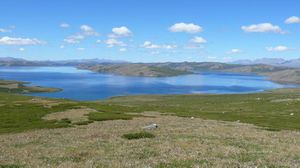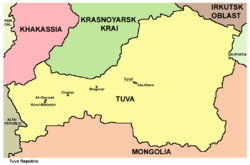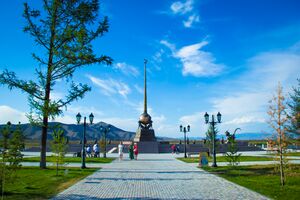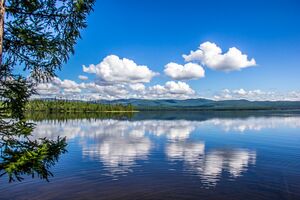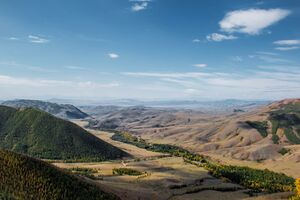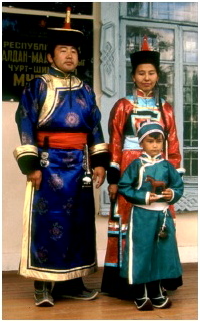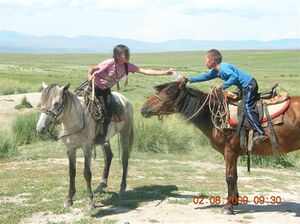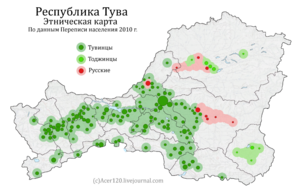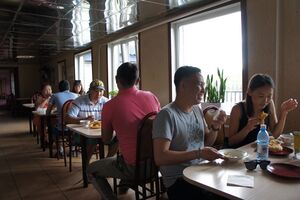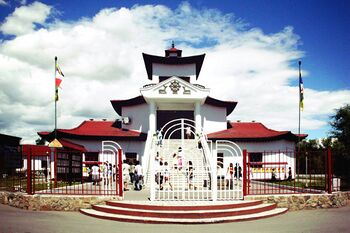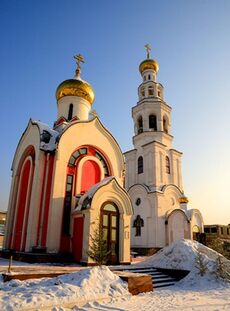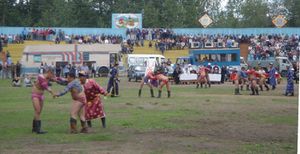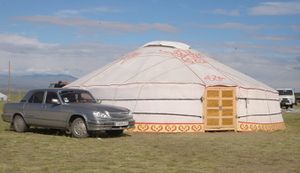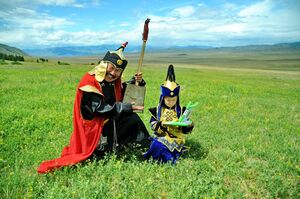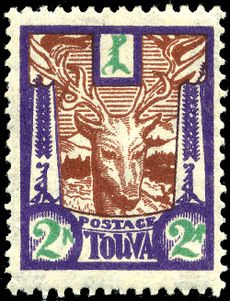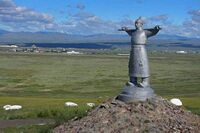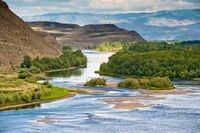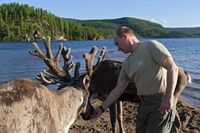توڤا
جمهورية توڤا | |
|---|---|
| Республика Тыва | |
| الترجمة اللفظية بالـ Other | |
| • Tuvan | Тыва Республика |
| النشيد: Men - Tyva Men | |
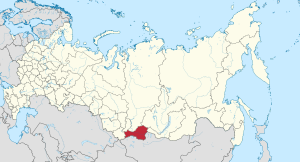 | |
| البلد | روسيا |
| المنطقة الاتحادية | Siberian[1] |
| المنطقة الاقتصادية | شرق سيبريا[2] |
| تأسست | October 13, 1944 |
| العاصمة | قزل |
| الحكومة | |
| • الكيان | الخورال الكبير[3] |
| • Chairman of the Government[5] | Sholban Kara-ool[4] |
| المساحة | |
| • Total | 170٬500 كم² (65٬800 ميل²) |
| ترتيب المساحة | 21st |
| التعداد (2010 Census)[7] | |
| • Total | 307٬930 |
| • Estimate (2018) | 321٬722 (+4٫5%) |
| • الترتيب | 77th |
| • الكثافة | 1٫8/km2 (4٫7/sq mi) |
| • Urban | 53٫1% |
| • الريف | 46٫9% |
| منطقة التوقيت | UTC+7 (توقيت كراسنويارسك |
| ISO 3166 code | RU-TY |
| لوحات السيارات | 17 |
| OKTMO ID | 93000000 |
| اللغات الرسمية | الروسية;[9] توڤا[10] |
| الموقع الإلكتروني | http://gov.tuva.ru/ |
توڤا هي احدى جمهوريات الاتحاد الروسي. وتحد منغوليا وتقع في مركز آسيا الجغرافي، تتجاور في اراضيها المناطق الصحراوية والجبلية والسهوب والغابات والمروج، اي كل المناطق المناخية لكرتنا الارضية. ان مساحتها تزيد عن مساحة تونس وان عدد سكانها 310 آلاف نسمة. اما عاصمتها فهي مدينة قيزيل التي اسست في اواخر القرن الثامن عشر.
إن التوفيين من اقدم شعوب اواسط آسيا. لديهم آثار ثقاقتهم الروحية. والى جانب البوذية يعبدون القوى الطبيعية، مثلما في الماضي البعيد. وبامكان من يزور الجمهورية من هواة الرحلات السياحية التعرف على التقاليد التوفية العريقة والسير في الخط السياحي الخاص الذي اطلق عليه اسم "اغنية الساحر" وهو يعرفهم بخصائص الغناء الحلقي المميز لهذا الشعب.
ان الغناء الحلقي المنتشر لدى التوفيين هو ظاهرة فريدة من نوعها وصفوها لاول مرة في القرن التاسع عشر. ومما يميزه ان المغنى يطلق ليس صوتا واحدا بل صوتين وحتى ثلاثة اصوات في آن واحد.
غنية هي ارض توفا بآثارها لعصور مختلفة. ويدهش تعددها وتنوعها حتى الخبراء. ويمكن رؤية الرسوم القديمة على الصخور والتماثيل الحجرية التي لا نعرف سرها بعد في كل مكان تقريبا. هناك في توفا حوالى عشرين الف تل والكثير منها أقدم كثيراً من الأهرامات المصرية.
وفي السنوات الاخيرة جاءت الحفريات الاثرية في احد التلال العائدة الى القرن السابع قبل الميلاد بمفاجأة كبيرة. اذ اكتشف علماء الآثار الروس والالمان الذين قاموا بها على مدافن قديمة، فيها عدد كبير من المصنوعات الذهبية، يصل اجمالى وزنها الى 20 كيلوغراما. والآن تعرض التماثيل الذهبية الصغيرة وملابس المراسيم الجميلة وغيرها مما وجدوه داخل التل في متحف ايرميتاج للفنون التشكيلية في سان بطرسبورغ وهو احد اكبر المتاحف في البلاد والعالم.
إن المناخ هنا قاري، تنخفض درجة حرارة الجو شتاء الى 50 درجة مئوية تحت الصفر وترتفع صيفا الى 40 فوق الصفر. اما عالم الحيوان، فهو متنوع لدرجة مدهشة. وفي اي مكان آخر على الارض يمكننا ان نرى الأيل الشمالي ونمر الثلج الارقط الى جانب الجمل.
إن جمهورية توفا تتخصص في الانتاج الزراعي. ومن فروعه الرئيسية تربية الحيويانات والخيل. وفي منطقة التوندرا ذات التربة المتجمدة يربون الايائل وفي الجبال ثيران الياق المنغولية وفي الاماكن شبه الصحراوية الجمال. ومنذ القدم كان التوفيون الرحل يمارسون تربيتها وهم يعيشون في الخيام المصنوعة من جلود الحيوانات في المراعى مباشرة.
. . . . . . . . . . . . . . . . . . . . . . . . . . . . . . . . . . . . . . . . . . . . . . . . . . . . . . . . . . . . . . . . . . . . . . . . . . . . . . . . . . . . . . . . . . . . . . . . . . . . . . . . . . . . . . . . . . . . . . . . . . . . . . . . . . . . . . . . . . . . . . . . . . . . . . . . . . . . . . . . . . . . . . . .
التاريخ
The territory of Tuva has been controlled by the Xiongnu Empire (209 BC – 93 AD) and the Xianbei state (93–234), Rouran Khaganate (330–555), Tang Dynasty (647–682), Yenisei Kyrgyz Khaganate (7th – 13th century), Mongol Empire (1206–1271), Yuan dynasty (1271–1368), Northern Yuan dynasty (1368–1691), Khotgoid Khanate and Zunghar Khanate (1634–1758).[11] Medieval Mongol tribes, including Oirats and Tumeds, inhabited areas which are now part of the Tuvan Republic.[11]
From 1758 to 1911, Tuva was part of China's Qing dynasty and administered by Outer Mongolia.[12] During the Xinhai Revolution in China, Tsarist Russia formed a separatist movement among the Tuvans while there were also pro-independence and pro-Mongol groups.[13] Tsar Nicholas II agreed to the third petition by Tuva's leadership in 1912, establishing a protectorate over the then-independent state. Some Russians, such as merchants, travellers, and explorers, had already settled in Tuva at that time.[14] Tuva became nominally independent as the Uryankhay Republic before being turned into a Russian protectorate as Uryankhay Krai under Tsar Nicholas II, on 17 April 1914.[15]
A Tuvan capital was established, called Belotsarsk (Белоца́рск; literally, "(Town) of the White Tsar").[16] Meanwhile, in 1911, Mongolia became independent, though under Russian protection. Following the Russian Revolution of 1917 that ended the imperial autocracy, most of Tuva was occupied from 5 July 1918 to 15 July 1919 by Alexander Kolchak's White Russian troops. Pyotr Ivanovich Turchaninov was named governor of the territory. In the autumn of 1918, the southwestern part was occupied by Chinese troops and the southern part by Mongol troops led by Khatanbaatar Magsarjav.[17]
From July 1919 to February 1920, the communist Red Army controlled Tuva but from 19 February 1920 to June 1921 it was occupied by China (governor was Yan Shichao [traditional, Wade–Giles transliteration: Yan Shi-ch'ao]). On 14 August 1921, the Bolsheviks established the Tuvan People's Republic, popularly called Tannu-Tuva. In 1926, the capital (Belotsarsk; Khem-Beldyr since 1918) was renamed Kyzyl, meaning "red". The Tuvan People's Republic was de jure an independent state between the World Wars. The state's ruler, Chairman Donduk Kuular, sought to strengthen ties with Mongolia and establish Buddhism as the state religion. This unsettled the Soviet Union, which orchestrated a coup carried out in 1929 by five young Tuvan graduates of Moscow's Communist University of the Toilers of the East.[18]
In 1930, the pro-Soviet regime discarded the state's Mongol script in favor of a Latin alphabet designed for Tuva by Russian linguists. In 1943, Cyrillic script replaced Latin. Under the leadership of Party Secretary Salchak Toka, ethnic Russians were granted full citizenship rights and Buddhist and Mongol influences on the Tuvan state and society were systematically curtailed.[19]
Tuva was annexed by the Soviet Union in 1944, with the approval of Tuva's Little Khural (parliament), but without a referendum on the issue. It became the Tuvan Autonomous Oblast, within the Russian Soviet Federative Socialist Republic, after the Soviet victory in World War II.[20] Salchak Toka, leader of the Tuvan People's Revolutionary Party, was given the title of First Secretary of the Tuvan Communist Party and became the de facto ruler of Tuva until his death in 1973.[21] The territory became the Tuvan Autonomous Soviet Socialist Republic on 10 October 1961.[20]
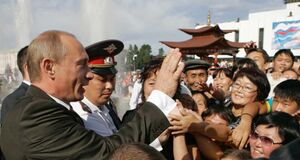
In February 1990, the Tuvan Democratic Movement was founded by Kaadyr-ool Bicheldei, a philologist at the Kyzyl State Pedagogical Institute. The party aimed to provide jobs and housing (both in short supply), and improve the status of the Tuvan language and culture. Later in the year, there was a wave of attacks against Tuva's sizeable Russian community, including sniper attacks on trucks, and attacks on outlying settlements, with 168 murdered.[22] Russian troops were eventually called in. Many Russians moved out of the republic during this period. Tuva has remained remote and difficult to access.[23]
Tuva was a signatory to the 31 March 1992 treaty that created the Russian Federation. On 22 October 1993, a new constitution was drawn up for the republic, creating a 32-member parliament (Supreme Khural) and a Grand Khural, which deals with local legislation.[24] The constitution was approved by 53.9% (62.2% according to another source) of Tuvans in a referendum on 12 December 1993.[25] At the same time, the official name was changed from Tuva (Тува) to Tyva (Тыва).[26]
الجغرافيا
The Tyva Republic is situated in the far south of Siberia. Its capital city is Kyzyl, located near the geographic "center of Asia". The eastern part of the republic is forested and elevated, while the western part is a drier lowland.
- Borders:
- internal: Khakassia (NW/N), Krasnoyarsk Krai (N), Irkutsk Oblast (N/NE), Buryatia (E), Altai Republic (SW/W)
- international: Mongolia (Bayan-Ölgii Province, Khövsgöl Province, Uvs Province and Zavkhan Province) (S) (border line length: 1,305 kilometers (811 mi))
- Highest point: Mount Mongun-Tayga, 3,970 meters (13,020 ft)
- Maximum N–S distance: 450 kilometers (280 mi)
- Maximum E–W distance: over 700 kilometers (430 mi)
- Area: 170,427 square kilometers (65,802 sq mi)
الأنهار
There are over 8,000 rivers in the Tyvan Republic, including the upper course of the Yenisei River, the fifth longest river in the world. Most of the republic's rivers are Yenisei tributaries. There are also numerous mineral springs in the area.
الأنهار الرئيسية تضم:
- Yenisei River (also called Ulug-Khem)
- Kantegir River
- Khemchik River
- Maly Yenisei River (also called Ka-Khem or Kaa-Khem)
- Upper Yenisei River (also called Biy-Khem or Bii-Khem)
البحيرات
There are numerous lakes in Tuva, many of which are glacial and salt lakes, including Todzha Lake, a.k.a. Azas Lake (100 km2) – the largest in the republic, and Uvs Lake (shared with Mongolia and a World Heritage Site).
الجبال
تتكون جمهورية توڤا من حوض جبلي، يبلغ ارتفاعه نحو 600 متر، وتحيط به سلاسل جبال سايان وتنّو-أولا. وتغطي الجبال والروابي أكثر من 80% من مساحة الجمهورية. مونگون-تايگا ("الجبل الفضي"، 3,970 م) هو أعلى نقطة في الجمهورية ومسمى على اسم مثلجتها.
التقسيمات الإدارية
الديموغرافيا
إحصائيات حيوية
- Source: Russian Federal State Statistics Service Archived 12 أبريل 2008 at the Wayback Machine[27]
| Years | Average population (x 1000) | Live births | Deaths | Natural change | Crude birth rate (per 1000) | Crude death rate (per 1000) | Natural change (per 1000) | Fertility rates |
|---|---|---|---|---|---|---|---|---|
| 1970 | 233 | 6,559 | 1,938 | 4,621 | 28.2 | 8.3 | 19.8 | |
| 1975 | 253 | 6,950 | 2,306 | 4,644 | 27.5 | 9.1 | 18.4 | |
| 1980 | 272 | 7,133 | 2,748 | 4,385 | 26.2 | 10.1 | 16.1 | |
| 1985 | 287 | 8,110 | 2,624 | 5,486 | 28.3 | 9.1 | 19.1 | |
| 1990 | 309 | 8,116 | 2,664 | 5,452 | 26.3 | 8.6 | 17.7 | 3.22 |
| 1991 | 304 | 7,271 | 2,873 | 4,398 | 23.9 | 9.5 | 14.5 | 2.97 |
| 1992 | 303 | 6,545 | 3,006 | 3,539 | 21.6 | 9.9 | 11.7 | 2.68 |
| 1993 | 302 | 6,130 | 3,480 | 2,650 | 20.3 | 11.5 | 8.8 | 2.50 |
| 1994 | 303 | 6,076 | 4,086 | 1,990 | 20.1 | 13.5 | 6.6 | 2.46 |
| 1995 | 304 | 6,172 | 4,010 | 2,162 | 20.3 | 13.2 | 7.1 | 2.47 |
| 1996 | 305 | 5,705 | 4,110 | 1,595 | 18.7 | 13.5 | 5.2 | 2.25 |
| 1997 | 305 | 4,908 | 3,954 | 954 | 16.1 | 12.9 | 3.1 | 1.91 |
| 1998 | 306 | 5,267 | 3,631 | 1,636 | 17.2 | 11.9 | 5.4 | 2.02 |
| 1999 | 306 | 4,894 | 4,142 | 752 | 16.0 | 13.5 | 2.5 | 1.86 |
| 2000 | 306 | 4,871 | 4,170 | 701 | 15.9 | 13.6 | 2.3 | 1.83 |
| 2001 | 305 | 4,992 | 4,165 | 827 | 16.3 | 13.6 | 2.7 | 1.85 |
| 2002 | 305 | 5,727 | 4,576 | 1,151 | 18.8 | 15.0 | 3.8 | 2.10 |
| 2003 | 305 | 6,276 | 4,633 | 1,643 | 20.6 | 15.2 | 5.4 | 2.28 |
| 2004 | 304 | 6,127 | 4,090 | 2,037 | 20.2 | 13.5 | 6.7 | 2.19 |
| 2005 | 303 | 5,979 | 4,326 | 1,653 | 19.8 | 14.3 | 5.5 | 2.11 |
| 2006 | 302 | 5,950 | 3,802 | 2,148 | 19.7 | 12.6 | 7.1 | 2.06 |
| 2007 | 302 | 7,568 | 3,687 | 3,881 | 25.1 | 12.2 | 12.9 | 2.60 |
| 2008 | 303 | 7,874 | 3,526 | 4,348 | 26.0 | 11.6 | 14.3 | 2.68 |
| 2009 | 305 | 8,242 | 3,666 | 4,576 | 27.0 | 12.0 | 15.0 | 2.97 |
| 2010 | 307 | 8,262 | 3,566 | 4,696 | 26.9 | 11.6 | 15.3 | 3.03 |
| 2011 | 308 | 8,478 | 3,403 | 5,075 | 27.5 | 11.0 | 16.5 | 3.25 |
| 2012 | 310 | 8,266 | 3,471 | 4,795 | 26.7 | 11.2 | 15.5 | 3.35 |
| 2013 | 311 | 8,111 | 3,399 | 4,728 | 26.1 | 10.9 | 15.2 | 3.42 |
| 2014 | 313 | 7,921 | 3,419 | 4,502 | 25.3 | 10.9 | 14.4 | 3.48 |
| 2015 | 315 | 7,489 | 3,258 | 4,231 | 23.8 | 10.3 | 13.5 | 3.39 |
| 2016 | 317 | 7,421 | 3,112 | 4,309 | 23.2 | 9.8 | 13.4 | 3.35 |
| 2017 | 320 | 6,977 | 2,788 | 4,189 | 21.9 | 8.7 | 13.2 | 3.19 |
| 2018 | 323 | 6,539 | 2,857 | 3,682 | 20.2 | 8.8 | 11.4 | 2.97 |
| 2019 | 326 | 6,158 | 2,718 | 3,440 | 18.6 | 8.3 | 10.3 | 2.72 |
| 2020 | 330 | 6,582 | 3,024 | 3,601 | 20.0 | 9.2 | 10.8 | 2.97 |
| 2021 | 332 | 6,629 | 3,028 | 3,558 | 20.0 | 9.1 | 10.9 | 2.94 |
| 2022 | 5,997 | 2,867 | 3,130 | 17.9 | 8.6 | 9.3 | 2.51 | |
| 2023 | 5,738 | 2,986 | 2,752 | 16.9 | 8.8 | 8.1 |
- Average life expectancy: Tuva: 56.5 (average male and female, UNDP data); Russia: (UN data) Male 59 (world rank 166); Female 73 (127)
. . . . . . . . . . . . . . . . . . . . . . . . . . . . . . . . . . . . . . . . . . . . . . . . . . . . . . . . . . . . . . . . . . . . . . . . . . . . . . . . . . . . . . . . . . . . . . . . . . . . . . . . . . . . . . . . . . . . . . . . . . . . . . . . . . . . . . . . . . . . . . . . . . . . . . . . . . . . . . . . . . . . . . . .
الجماعات العرقية
According to the 2021 Census,[28] Tuvans make up 88.7% of the population. Other groups include Russians (10.1%), and a host of smaller groups, each accounting for less than 0.5% of the total population.
| Ethnic group |
1959 census | 1970 census | 1979 census | 1989 census | 2002 census | 2010 census | 2021 census1 | |||||||
|---|---|---|---|---|---|---|---|---|---|---|---|---|---|---|
| Number | % | Number | % | Number | % | Number | % | Number | % | Number | % | Number | % | |
| Tuvans | 97,996 | 57.0% | 135,306 | 58.6% | 161,888 | 60.5% | 198,448 | 64.3% | 235,313 | 77.0% | 249,299 | 82.0% | 279,789 | 88.7% |
| Russians | 68,924 | 40.1% | 88,385 | 38.3% | 96,793 | 36.2% | 98,831 | 32.0% | 61,442 | 20.1% | 49,434 | 16.3% | 31,927 | 10.1% |
| Khakas | 1,726 | 1.0% | 2,120 | 0.9% | 2,193 | 0.8% | 2,258 | 0.7% | 1,219 | 0.4% | 877 | 0.3% | 359 | 0.1% |
| Others | 3,282 | 1.9% | 5,053 | 2.2% | 6,725 | 2.5% | 9,020 | 2.9% | 7,526 | 2.5% | 4,427 | 1.4% | 3,483 | 1.1% |
| 121,093 people were registered from administrative databases, and could not declare an ethnicity. It is estimated that the proportion of ethnicities in this group is the same as that of the declared group.[29] | ||||||||||||||
| التعداد التاريخي | ||
|---|---|---|
| السنة | تعداد | ±% |
| 1959 | 171٬928 | — |
| 1970 | 230٬864 | +34.3% |
| 1979 | 266٬453 | +15.4% |
| 1989 | 309٬129 | +16.0% |
| 2002 | 305٬510 | −1.2% |
| 2010 | 307٬930 | +0.8% |
| 2021 | 336٬651 | +9.3% |
| Source: Census data | ||
During the period from 1959–2010, there was more than a doubling of ethnic Tuvans. The Russian population growth slowed by the 1980s and decreased by 70% since 1989. The official languages are Tuvan (Turkic) and Russian (Slavic).
Outside Kyzyl, settlements have few if any Russian inhabitants and, in general, Tuvans use their original language as their first language. However, there is a small population of Old Believers in the Republic scattered in some of the most isolated areas. Before Soviet rule, there were a number of large ethnic Russian Old Believer villages, but as atheism spread, the believers moved deeper and deeper into the taiga in order to avoid contact with outsiders. Major Old Believer villages are Erzhei, Uzhep, Unzhei, Zhivei and Bolee Malkiye (all in the Kaa-Khemsky District). Smaller ultra-Orthodox settlements are found further upstream.[30]
Ethnic Russians make up 27.4% of the population (as of the 2021 census) in Kaa-Khemsky District, one of the most remote regions in Tuva. The population is mostly Old Believers.[31] Russians account for 18.9% of the population in Piy-Khemsky and 16.4% in Kyzyl.[32]
الديانة
Two religions are widespread among the Tuvan people: Tibetan Buddhism and shamanism. Tibetan Buddhism's present-day spiritual leader is Tenzin Gyatso, the fourteenth Dalai Lama. In September 1992, Tenzin Gyatso visited Tuva for three days.[35] On September 20, he blessed and consecrated the yellow-blue-white flag of Tuva, which had been officially adopted three days before.[36]
The Tuvan people – along with the Yellow Uyghurs in China – are one of the only two Turkic groups who are primarily adherents to Tibetan Buddhism, which coexists with native shamanistic traditions.[37]
Tuvans were first exposed to Buddhism during the 13th and 14th centuries, when Tuva entered into the composition of the Mongol Empire. The earliest Buddhist temples uncovered by archaeologists in the territory of Tuva date to the 13th and 14th centuries.[38] During the 16th and 17th centuries, Tibetan Buddhism gained popularity in Tuva. An increasing number of new and restored temples are coming into use, and there has been an upward trend in the number of novices being trained as monks and lamas in recent years. Religious practice declined under the restrictive policies of the Soviet period, but is now flourishing.[39][40]
According to a 2012 survey,[33] 61.8% of the population of Tuva adheres to Buddhism, 8% to Tengrism or Tuvan shamanism, 1.5% to the Russian Orthodox Church, the Old Believers or other forms of Christianity, 1% to Protestantism. In addition, 7.7% follow other religions or did not give an answer to the survey. 8% of the population declares to be "spiritual but not religious" and 12% to be atheist.[33]
. . . . . . . . . . . . . . . . . . . . . . . . . . . . . . . . . . . . . . . . . . . . . . . . . . . . . . . . . . . . . . . . . . . . . . . . . . . . . . . . . . . . . . . . . . . . . . . . . . . . . . . . . . . . . . . . . . . . . . . . . . . . . . . . . . . . . . . . . . . . . . . . . . . . . . . . . . . . . . . . . . . . . . . .
السياسة
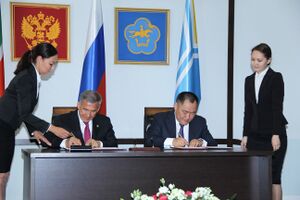
The present flag of Tuva – yellow for prosperity, blue for courage and strength, white for purity – was adopted on 17 September 1992. The Republic's Constitution was adopted on 23 October 1993.
The head of Tuva is the chairman of the government and serves a five-year term which can be renewed. The first Chairman of the Government was Sherig-ool Oorzhak. On 3 April 2007, Russian president Vladimir Putin nominated Sholban Kara-ool, 40, a former champion wrestler, as the Chairman of the Government of Tuva.[41] Kara-ool's candidacy was approved by the Khural on 9 April 2007.[42] Kara-ool served from 2007 until 2021. The third and current Tuvan head of government is Vladislav Khovalyg.
Tuva's legislature, the Great Khural, has 32 seats as of 2023; each deputy is elected to serve a five-year term.
الاقتصاد
In Tuva, there are a total of approximately 7,400 unemployed, which gives a 5.9% unemployment rate [43] and is above the overall Russian unemployment rate of 4.9% [44]
التعدين
Mining is a crucial element of the Tuvan economy. It is estimated that in 2020, there were 40 million metric tonnes of coal produced in Tuva,[45] which accounts for approximately 9.4% of Russia's average annual coal production of 423 million metric tonnes.[46]
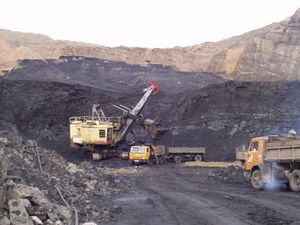
يكمن في باطن أرض توفا اكثر من 200 مكمن للثروات الطبيعية ومن أكبرها مصدر الأسبست الأبيض، المادة الضرورية لانتاج المصنوعات العامدة للنار والعازلة للحرارة. وتعمل فيه احدى أكبر مؤسسات الاستخراج في الجمهورية. أما الفرع الأهم من فروع صناعتها، فهو الميتالرجيا غير الحديدية التي تقوم على استخراج الذهب. ويقوم التوفيون باستخراج حوالى طنين من الذهب في السنة.
الثقافة
Traditionally, the Tuvan people are a Central Asian yurt-dwelling nomadic culture, with distinctive traditions in music, cuisine, and folk art. Tuvan music features Tuvan throat singing (khoomei), in which the singer sings a fundamental tone and an overtone simultaneously. This type of singing can be heard during performances by the Tuvan National Orchestra, at events such as the 'International Khoomei Day' held at the National Tuvinian Theatre in Kyzyl.[47]
The Tuvan craft tradition includes carving the soft stone, agalmatolite. A frequent motif is hand-held-sized animals, such as horses.[48]
Important archaeological excavations in Tuva include Arzhaan-1 and Tunnug 1,[49] dating to the ninth century BC.[50] and Arzhaan-2, where Scythian animal art in great variety, and over 9,000 decorative gold pieces were unearthed.[51] A collection of gold jewelry from this site is on display at the National Museum Aldan-Maadyr in Kyzyl.[47]
Festivals celebrating Tuvan traditions include the ecological film festival "The Living Path of Dersu", the Interregional Festival of National Cultures "Heart of Asia". It has become a tradition to hold the international festival of live music "Ustuu-Khuree", the International Symposium "Khoomei – the Phenomenon of the Culture of the Peoples of Central Asia", the Regional Competition-Festival of Performers on National Instruments "Dingildai", the International Felt Festival "Patterns of Life on Felt" Pop songs "Melodies of the Sayan Mountains".[52]
شعب توڤا يشتهر بـغناء توڤا الحلقي.
يشتهر أبناء توفا بمهارتهم العالية في نحت تماثيل الحيوانات الصغيرة، مستعملين حجر أگالماتوليت المحلي اللين. ان لونه يختلف من الاسود الفضي الى الوردي الذهبي. واذا سافرتم الى هذه الاماكن فلا تنسوا ان تشتروا اجمل هدية تذكارية من صنع الحرفيين المحليين هي تمثال صغير للحيوان "ارزيلان" السحري الذي يعتبرونه تجسيدا للقوة. ان كلمة "ارزيلان" تعنى باللغة التوفية "الاسد" لكن نحاتي الماضي لم يروا الاسد الحقيقي، ولو مرة في حياتهم. وكانوا يصغون اسودهم الصغيرة السحرية حسب تصوراتهم وحيالهم. اما حرفيو اليوم فيحافطون على تقاليدهم.
الدين
Tuva is one of the few places in the world where the original form of shamanism is preserved as part of the traditional culture of Tuva. Shamanism presupposes the existence of good and evil spirits inhabiting mountains, forests and water, as well as the heavens and the underworld. The mediator between man and the spirits is the shaman. It is believed that with the help of spirits the shaman is able to cure patients and predict the future.[47]
In Tuva, shamanism peacefully coexists with Buddhism. Buddhism is associated with many folk rituals, calendar holidays, and folk medicines in Tuva. Centers of Buddhism in Tuva are Khuree – temples, temple complexes; the temple complex Tsechenling in Kyzyl is the residence of Khambo Lama, head of Buddhism in Tuva. Treasures of the old Slavonic culture in the Asian Tuva saved along with the values of other peoples – children's folklore ensemble "Oktay" from the city of Kyzyl in the course several ethnographic expeditions in the old believers ' settlements were able to collect an extensive collection of samples of ancient singing art.[47]
معرض الصور
انظر أيضاً
المراجع
- ^ Президент Российской Федерации. Указ №849 от 13 мая 2000 г. «О полномочном представителе Президента Российской Федерации в федеральном округе». (President of the Russian Federation. Decree #849 of May 13, 2000 On the Plenipotentiary Representative of the President of the Russian Federation in a Federal District).
- ^ Госстандарт Российской Федерации. №ОК 024-95 27 декабря 1995 г. «Общероссийский классификатор экономических регионов. 2. Экономические районы», в ред. Изменения №5/2001 ОКЭР. (گوستاندارت of the Russian Federation. #OK 024-95 December 27, 1995 Russian Classification of Economic Regions. 2. Economic Regions, as amended by the Amendment #5/2001 OKER).
- ^ Constitution, Article 10.2
- ^ Official website of the Government of the Tyva Republic. Sholban Valeryevich Kara-ool (بالروسية)
- ^ Constitution, Article 10.3
- ^ Федеральная служба государственной статистики (Federal State Statistics Service) (2004-05-21). "Территория, число районов, населённых пунктов и сельских администраций по субъектам Российской Федерации (Territory, Number of Districts, Inhabited Localities, and Rural Administration by Federal Subjects of the Russian Federation)". Всероссийская перепись населения 2002 года (All-Russia Population Census of 2002) (in الروسية). Federal State Statistics Service. Retrieved 2011-11-01.
- ^ خطأ استشهاد: وسم
<ref>غير صحيح؛ لا نص تم توفيره للمراجع المسماة2010Census - ^ "Об исчислении времени". Официальный интернет-портал правовой информации (in الروسية). 3 June 2011. Retrieved 19 January 2019.
- ^ الرسمية في جميع أرجاء روسيا الاتحادية حسب الفقرة 68.1 من دستور روسيا.
- ^ Constitution, Article 5.1
- ^ أ ب History of Mongolia, Volume II, 2003.
- ^ Shurkhuu, D. (2014). "Similarities and Differences between Mongolia and Tuva in the Evolution of Bilateral Ties" (PDF). Senri Ethnological Studies. 86: 127–144. Archived from the original (PDF) on 18 May 2015. Retrieved 14 May 2015.
- ^ L. Zhazhmsran. 1995
- ^ "Статья в Мегаэнциклопедии Кирилла и Мефодия". megabook.ru (in الروسية). Retrieved 19 December 2020.
- ^ Robertson, P. (2011). Robertson's Book of Firsts: Who Did What for the First Time. Bloomsbury Publishing. ISBN 9781608197385. Retrieved 19 December 2020.
- ^ "Kyzyl city, Russia info, features, photos". russiatrek.org. Retrieved 2015-11-03.
- ^ Shuldyakov, V.A. (2008). Сибирские казаки в Урянхайском крае (1918–1919): неизвестная страница Гражданской войны (in الروسية). Vol. 3 (Современные научные исследования: теория, методология, практика: Сб. науч. тр. профессорско-препод. состава по итогам отчетов кафедры обществен-ных наук по НИР за 2007 г. Вып. 2. ed.). Omsk: ANO VPO "Omsk Economic Institute" Press. pp. 114–132.
- ^ Forsyth, James (1994). A History of the Peoples of Siberia: Russia's North Asian Colony 1581–1990. Cambridge: Cambridge University Press. p. 281. ISBN 052-147-771-9.
- ^ "Tuva: Russia's Tibet or the Next Lithuania?". Retrieved February 22, 2018.
- ^ أ ب "ТЫВА Tuva". hubert-herald.nl. Retrieved 5 November 2020.
- ^ "Сын своего времени". tuva.asia (in الروسية). Retrieved 19 December 2020.
- ^ Mark R. Beissinger, Nationalist Mobilization and the Collapse of the Soviet State, Cambridge University Press, 2002, pg. 230
- ^ "Tuva". Geographic Bureau — Siberia and Far East/Tuva. Archived from the original on نوفمبر 26, 2015. Retrieved مايو 4, 2016.
- ^ "Конституция Республики Тыва". gov.tuva.ru (in الروسية). Archived from the original on 9 August 2020. Retrieved 9 May 2019.
- ^ ”Tyva republic approves own constitution”, BBC Monitoring Service, December 15, 1993.
- ^ "Конституция Республики Тува — ОСНОВЫ КОНСТИТУЦИОННОГО СТРОЯ Статья 1. п 2" (in الروسية). Retrieved 19 December 2020.
The names Republic of Tuva and Tuva are equivalent
- ^ Каталог публикаций::Федеральная служба государственной статистики (in الروسية). Gks.ru. May 8, 2010. Archived from the original on 24 December 2018. Retrieved 27 May 2013.
- ^ "Национальный состав населения". Federal State Statistics Service. Retrieved 30 December 2022.
- ^ "Перепись-2010: русских становится больше". Perepis-2010.ru. Retrieved November 16, 2012.
- ^ "ESCAPING WITHIN: LOST IN THE BOUNDARIES: A REPORT FROM THE FIELD" (PDF). condor.depaul.edu. Archived from the original (PDF) on September 9, 2011.
- ^ Староверы Республики Тыва. Фото (in الروسية). Rodonews.ru. Archived from the original on 13 March 2016. Retrieved November 16, 2012.
- ^ Этносоциальный профиль тувинцев (in الروسية). tuva.asia. June 2, 2016.
- ^ أ ب ت "2012 Arena: Atlas of Religions and Nationalities in Russia". sreda.org; retrieved February 22, 2018.
- ^ 2012 Arena Atlas Religion Maps. "Ogonek", № 34 (5243), August 27, 2012; retrieved February 22, 2018. Arena Atlas Religion Maps (archived)
- ^ "Dalai Lama". Avantart.com. Retrieved November 16, 2012.
- ^ The World Encyclopedia of Flags; ISBN 1-84038-415-8
- ^ "Russia's Daily Online". Kommersant. Archived from the original on 4 April 2016. Retrieved November 16, 2012.
- ^ Zhukovskaia, N. L. (2001-04-01). "Lamaism in Tuva". Anthropology & Archeology of Eurasia. 39 (4): 48–49. doi:10.2753/AAE1061-1959390448. ISSN 1061-1959. S2CID 144636457.
- ^ "Russia – Uvs Nuur Basin". worldheritage.heindorffhus.dk. Archived from the original on August 30, 2006.
- ^ "Tyvans keen to protect traditions". BBC News. September 19, 2009. Retrieved November 16, 2012.
- ^ "Tuva-Online: New Head for Tuva Chosen by President Putin". En.tuvaonline.ru. Retrieved November 16, 2012.
- ^ "Tuva-Online: 40-year-old Head of Tuva Backed by Parliament". tuvaonline.ru. Retrieved December 22, 2017.
- ^ "The unemployment rate in Tuva has almost halved in six months".
- ^ "Unemployment rate of Russia (2018 - 2026, %)".
- ^ "The Republic of Tuva and the State of Russian Coal Exports". 14 March 2012.
- ^ "Coal Production by Country - Worldometer".
- ^ أ ب ت ث "The Republic of TUVA, travel guide" (PDF). ИПК «ПЛАТИНА». 1: 50. 2016.
- ^ "TUVANS | Facts and Details".
- ^ Caspari, Gino; Sadykov, Timur; Blochin, Jegor; Hajdas, Irka (2018-09-01). "Tunnug 1 (Arzhan 0) – an early Scythian kurgan in Tuva Republic, Russia". Archaeological Research in Asia. 15: 82–87. doi:10.1016/j.ara.2017.11.001. ISSN 2352-2267. S2CID 135231553.
- ^ Bourova, N. (2005). "Horse Remains from the Arzhan-1 and Arzhan-2 Scythian Monuments". Impact of the Environment on Human Migration in Eurasia. NATO Science Series: IV: Earth and Environmental Sciences. Vol. 42. pp. 323–332. doi:10.1007/1-4020-2656-0_24. ISBN 1-4020-2655-2.
- ^ "FOCUS ON TUVA: Stunning treasures – and macabre slaughter – in Siberia's Valley of the Kings". Siberiantimes.com. Retrieved 2022-03-19.
- ^ Культура Республики Тыва – Официальный портал Республики Тыва. gov.tuva.ru (in الروسية). Archived from the original on 29 July 2020. Retrieved July 24, 2017.
- DONAHOE, Brian 2002. "Hey, you! Get offa my taiga!": Comparing the sense of property rights among the Tofa and Tozhu-Tyva. Max Planck Institute for Social Anthropology working papers, nº 38. Halle/Saale: Max Planck Institute for Social Anthropology, Max-Planck-Gesellschaft. ISSN 1615-4568
- 6 мая 2001 г. «Конституция Республики Тыва», в ред. Конституционного закона №748 ВХ-2 от 7 июля 2008 г. (May 6, 2001 Constitution of the Tyva Republic, as amended by the Constitutional Law #748 VKh-2 of July 7, 2008).
وصلات خارجية
- (بالروسية) Official website of Tuva
- Photos from Tuva by Stanislav Krupar
- Research among the Tyvans of South Siberia
- WorldStatesmen- Russia
- Singing Stones -The Republic of Tuva
- (بالروسية) Website of Tuva
- (إنگليزية) Friends of Tuva website
- (إنگليزية) (Japanese) Friends of Tuva, Japan
- (إنگليزية) Some Tuvan stamps issued in 1920s/1930s
- (إنگليزية) Genghis Blues, official movie site
- (إنگليزية) Animated slideshow presentations of Tuva
- (إنگليزية) (بالروسية) (Japanese) قالب:Eo iconMore complete collection of Tuva Stamps (1926-1943)
- (إنگليزية) TyvaWiki:Main Page
- (إنگليزية) The Tuva Trader; Tuva and Richard Feynman media, products and information
- (إنگليزية) Buga-shadara A traditional Tuvan boardgame
- Audio of the Tuvan national anthem recorded by the Tuvan National Orchestra. The orchestral arrangement was composed by Ayana Samiyaevna Mongush.
| مناطق النزاع في شرق، جنوب، وجنوب شرق آسيا | |||
|---|---|---|---|
| النوع | المنطقة | الادارة الحالية | المطالبات |
| أراضي: | أكساي تشين | ||
| جبل بائكدو | |||
| Heixiazi / بولشوي اوسورييسكي (الجزء الشرقي)2 | |||
| Indo-Bangladesh enclaves3 | |||
| محافظة كاتشين | |||
| كشمير3 | |||
| محافظة كايين | |||
| شبه الجزيرة الكورية والجزر القريبة منها3 | |||
| بر الصين الرئيسي | |||
| شمال بورنيو (صباح)2 | |||
| منغوليا الخارجية2 | |||
| جبال پامير3 | |||
| فطاني | |||
| دولة شان | |||
| القرى الستة وأربعين شرق النهر2 | |||
| جنوب التبت (الآن أرونچال پرادش في الهند) | |||
| Tannu Uriankhai (now Tuva Republic of Russia)2 | |||
| Trans-Karakoram Tract | |||
| دولة وا | |||
| جزر ومياه: | جزر دياو يو تاي/ جزر سنكاكو | ||
| Kinmen | |||
| Kori Creek2 | |||
| Liancourt Rocks | |||
| Macclesfield Bank | |||
| Matsu | |||
| Paracel Islands | |||
| Pedra Branca, Middle Rocks, and South Ledge | |||
| جزر پراتاس | |||
| Scarborough Shoal | |||
| Socotra Rock | |||
| جزر كوريل الجنوبية | |||
| جزر سپراتلي3 | |||
| تايوان وPenghu2 | |||
| الهوامش: | 1حكومة في المنفى/جماعة منفية. 2Inactive dispute. 3Divided among multiple claimants. | ||
- Articles containing روسية-language text
- CS1 الروسية-language sources (ru)
- CS1 uses الروسية-language script (ru)
- Short description is different from Wikidata
- Pages using infobox settlement with no coordinates
- Articles with hatnote templates targeting a nonexistent page
- توڤا
- دويلات توركية ذاتية
- دول وأراضي تأسست في 1944
- أعضاء منظمة الأمم والشعوب غير الممثلة
- جمهوريات روسيا



